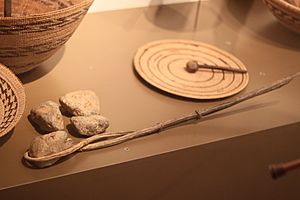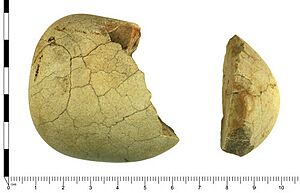Pot boiler facts for kids
In archaeology (the study of human history through digging up old things) and anthropology (the study of human societies and cultures), a pot boiler is a special kind of heated stone. People used these stones to warm up water. They were especially useful for groups who did not have pots made of clay or metal. These stones are also called cooking stones.
Contents
What is a Pot Boiler Stone?
A pot boiler stone helps move heat from a fire to a container of water. This makes the water hot, often for cooking. First, the stone is heated up in a fire or in hot ashes. Once it is very hot, people carefully move the stone into a container filled with water. The hot stone then heats the water inside.
What Containers Were Used?
People used different types of containers with pot boiler stones. Sometimes, they used metal pots, but this was less common. Metal pots are usually strong enough to be placed directly over a fire. Clay pots that were not strong enough for direct fire heat could also be used. Wooden troughs were another option.
Before people made pottery, they had clever ways to heat water. They might line a pit in the ground with leather, leaves, or clay. Then, they would add water to this lined pit. Finally, they would drop the hot pot boiler stones directly into the water to heat it.
How Do We Identify Pot Boiler Stones?
Archaeologists can recognize pot boiler stones because of how they look. When a stone is heated many times and then quickly cooled in water, it gets very stressed. This stress causes tiny cracks to form all over the stone's surface. This pattern of cracks is often called "crazing". The surface might also look a bit shiny or "glazed."
Eventually, the stone breaks into smaller pieces. People might reuse these smaller pieces until they are too tiny to handle. Then, the broken pieces are thrown away. On old sites where people lived for a long time, archaeologists can find many tonnes of these broken pot boiler fragments.
Sometimes, these broken pieces might have been used for building. However, their small size usually made them not very useful for construction.

How Are They Different from Hearth Stones?
The "crazing" pattern (fine cracks) is not only found on pot boiler stones. Stones around a fireplace, called hearth stones, can also show these cracks. However, there's a key difference. Pot boiler stones had to be moved in and out of the fire. People often used sticks of green wood to do this.
Pot boiler stones started out weighing a few kilograms. They got smaller as they broke apart from repeated use. Hearth stones, on the other hand, were usually much larger and stayed in one place. This helps archaeologists tell them apart.


